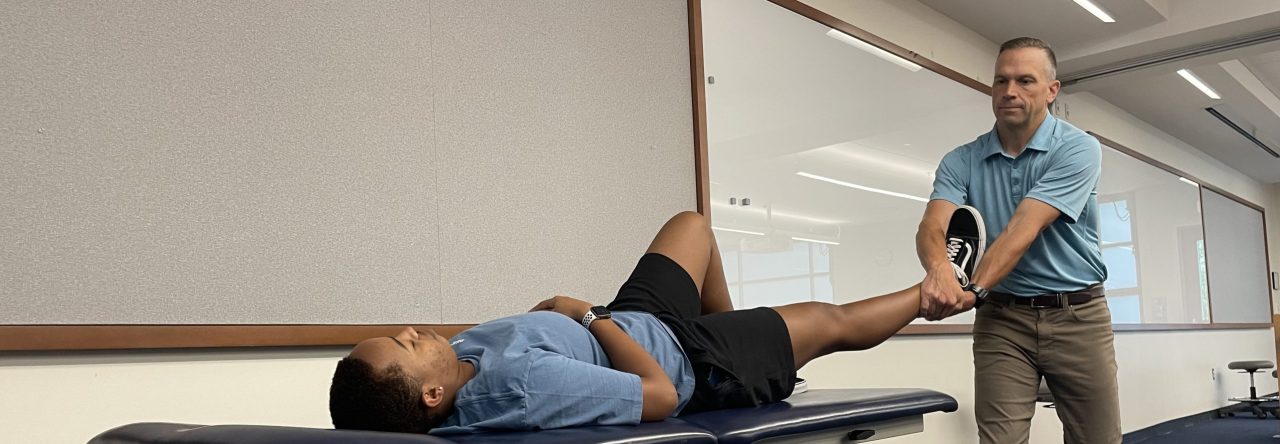Author Names
Kim, S; An, C; Cha, Y; Kim, D
Reviewer Name
Dylan Scott, SPT
Reviewer Affiliation(s)
Duke University
Paper Abstract
Objective The purpose of this study was to investigate the effect of 4 weeks of sling-based manual therapy on the cervicothoracic junction (CTJ) area in patients with neck pain and forward head posture. Design Single-blind randomized controlled trial. Setting Outpatient, Chonbuk National University hospital, Republic of Korea. Subjects A total of 22 participants with neck pain (Numeric Pain Rating Scale >3) and forward head posture (craniovertebral angle <51) were randomly assigned to a CTJ group or a control group (n = 11 each). Intervention In the control group, joint mobilization and motor control training was applied for the upper cervical spine (C0–C1). The CTJ group applied the same intervention to the upper cervical spine and cervicothoracic junction (C7-T3). Main measures Numeric pain rating scale and neck disability index, craniovertebral angle, active range of motion, and muscle activity were evaluated before and after 4 weeks of intervention. Result The CTJ group participants showed significant improvement in the craniovertebral angle and cervical extension range after the intervention than the control group (P = 0.025, P = 0.001). While both groups presented significant differences after the intervention regarding Numeric pain rating scale, neck disability index, and muscle activity (sternocleidomastoid and anterior scalene muscle), there were no statistically significant differences between the groups (P > 0.05). Conclusion Our results suggest that the CTJ and the upper cervical region in patients with neck pain and forward head posture represent an area which if approached by manual therapy, improves cervical mobility and posture.
NIH Risk of Bias Tool
Quality Assessment of Controlled Intervention Studies
- Was the study described as randomized, a randomized trial, a randomized clinical trial, or an RCT
- Yes
- Was the method of randomization adequate (i.e., use of randomly generated assignment)?
- Yes
- Was the treatment allocation concealed (so that assignments could not be predicted)?
- Yes
- Were study participants and providers blinded to treatment group assignment?
- Yes
- Were the people assessing the outcomes blinded to the participants’ group assignments?
- No
- Were the groups similar at baseline on important characteristics that could affect outcomes (e.g., demographics, risk factors, co-morbid conditions)?
- Yes
- Was the overall drop-out rate from the study at endpoint 20% or lower of the number allocated to treatment?
- Yes
- Was the differential drop-out rate (between treatment groups) at endpoint 15 percentage points or lower?
- Yes
- Was there high adherence to the intervention protocols for each treatment group?
- Yes
- Were other interventions avoided or similar in the groups (e.g., similar background treatments)?
- Yes
- Were outcomes assessed using valid and reliable measures, implemented consistently across all study participants?
- Yes
- Did the authors report that the sample size was sufficiently large to be able to detect a difference in the main outcome between groups with at least 80% power?
- Cannot Determine, Not Reported, or Not Applicable
- Were outcomes reported or subgroups analyzed prespecified (i.e., identified before analyses were conducted)?
- Yes
- Were all randomized participants analyzed in the group to which they were originally assigned, i.e., did they use an intention-to-treat analysis?
- Yes
Key Finding #1
Sling-based manual therapy significantly improved cervical and thoracic range of motion in patients with neck pain and forward head posture.
Key Finding #2
Patients who received sling-based manual therapy had significant reductions in pain intensity and disability related to neck pain compared to the control group.
Key Finding #3
The group receiving manual therapy using a sling showed a statistically significant improvement in cervical range of motion compared to the control group.
Key Finding #4
The improvements in pain, disability, and range of motion were maintained at 1-month follow-up, suggesting that the effects of sling-based manual therapy were lasting.
Please provide your summary of the paper
The study was conducted as a randomized clinical trial with 30 participants. The participants were randomly assigned to a sling-based manual therapy group or a control group. The intervention group received a sling-based manual therapy program for three weeks, while the control group received no intervention. The researchers measured the participants’ cervicothoracic junction range of motion, pain level, and muscle activity before and after the intervention. The results showed that the intervention group had significantly greater improvements in cervicothoracic junction range of motion and muscle activity compared to the control group. Additionally, the intervention group had significantly reduced pain levels compared to the control group. Based on these findings, the researchers concluded that sling-based manual therapy can be an effective intervention for patients with neck pain and forward head posture.
Please provide your clinical interpretation of this paper. Include how this study may impact clinical practice and how the results can be implemented.
The results suggest that using a sling-based manual therapy approach can lead to significant improvements in cervical and thoracic range of motion, as well as significant reductions in pain in patients with neck pain and forward head posture. This approach can be implemented along with other interventions such as exercise and body mechanics modifications. Although further research is needed to determine the dosage and frequency of this treatment, it can be implemented in a variety of clinical settings and is a valuable treatment option for physical therapists to have.
